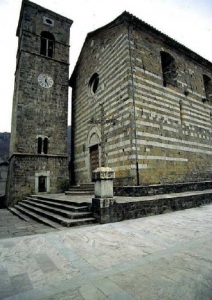Saint Regolo

Information
Foundation:
XII-XIII century
District/Location:
Vagli di Sotto
District:
Garfagnana


In the town centre, this church contains traces of its original construction, despite the numerous interventions from between the 16th and 19th century. Most notable are two important wooden sculptures dating to the 13th and 14th century.
Vagli di Sotto
In the main square, this church is traditionally dependent on the parish church of Piazza al Serchio and thought to have been built between the 12th and 13th century, although it underwent a number of enlargements and reconstruction works between the 16th and 19th century. The area historically belonged to the diocese of Luni and the "Decime" of 1296 records the "Chapel de Valle de Sucto" as dependent on the Parish Church de Castello (Piazza al Serchio). Included in the new diocese of Massa in 1822, it was passed to that of Lucca in 1992. A privilege dating to 1154 mentions a church of S. Maria "in castro Valli" or rather "de Volio inferiori": this is possibly a reference to this church, that only assumed the title of S. Regolo when the nearby church of that name was renamed S. Agostino, having been taken over by Augustinian nuns. The "Pastoral Visit" of the diocese of Luni by Bishop Lomellini in 1568 attributes the church of Vagli with the titles of S. Maria and S. Regolo. The façade has alternate bands of stone and white marble, a portal with architrave surmounted by a lunette and a rose window outlined by concentric cornices. The entrance steps reveal fragments of ancient sculptural decoration. Inside there is a 15th century holy-water basin by an anonymous artist from Luni and a lavabo with the insignia of the Este family. Also of great interest, a 13th – 14th century wooden sculpture of Madonna and Child stemming from the conspicuous Madonna “on-the-throne” tradition easily found in the Lucca area, and a wooden Crucifix, recently attributed to the artist known as the Maestro of the Crucifix of Camaiore, whose works can be found in Pietrasanta, Massa, Gallicano and Castiglione from the first half of the 14th century.
Scopri altre attrazioni vicino a Saint Regolo
See allYou may also like..
See allFind more
0











